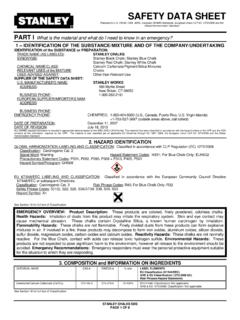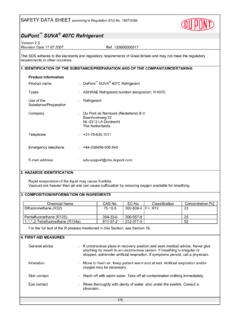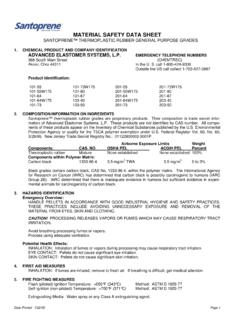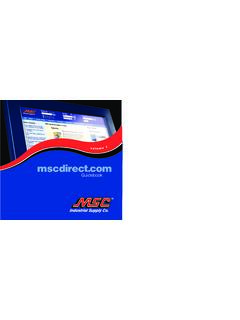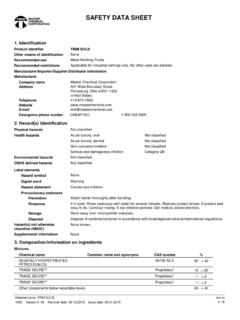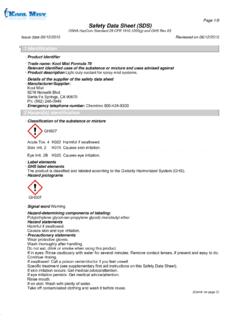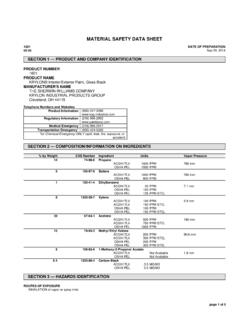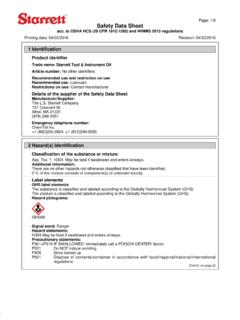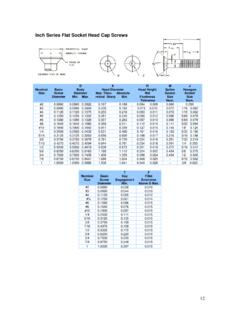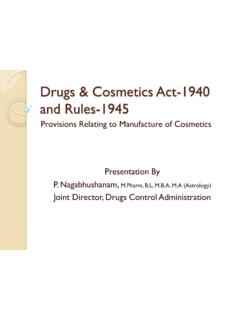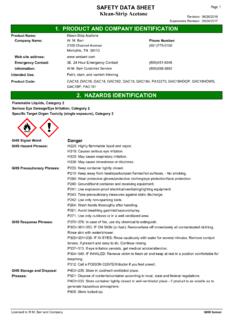Transcription of SAFETY DATA SHEET 1 Denatured Alcohol
1 1 Page: Denatured AlcoholSAFETY DATA SHEET13006/08/201204/14/2009 Revision:Supercedes Revision:09/12/2012 Printed:X*203 InstabilitySpecial HazardHealthFlammabilityHEALTHFLAMMABILI TYPHYSICALPPE1. Product and Company Code: Denatured AlcoholProduct Name:Manufacturer InformationW. M. Barr Company Name:2105 Channel AvenueMemphis, TN 38113(901)775-0100 Phone Number:3E 24 Hour Emergency Contact (800)451-8346 Emergency Barr Customer Service (800)398-3892 Web site Barr EHS Dept (901)775-0100 Preparer Name:SynonymsCSL26, DSL26, GSL26, QSL262. Hazards IdentificationGHS ClassificationGHS Hazard PhrasesNo data Precaution PhrasesNo data Response PhrasesNo data Storage and Disposal PhrasesNo data Health Effects (Acute and Chronic)Inhalation Acute Exposure Effects:Vapor harmful.
2 May cause dizziness, headache, watering of eyes, irritation of respiratory tract, irritation to theeyes, drowsiness, nausea, other central nervous system effects, spotted or blurry vision, dilation of pupils, Contact Acute Exposure Effects:May cause irritation, drying of skin, redness, and dermatitis. May cause symptoms listed under inhalation. Maybe absorbed through damaged Contact Acute Exposure Effects:May cause Acute Exposure Effects:Poison. Cannot be made non-poisonous. May be fatal or cause blindness. May produce fluid in the lungs andpulmonary edema. May cause dizziness, headache, nausea, drowsiness, loss of coordination, stupor, reddening offace and or neck, liver, kidney and heart damage, coma, and death.
3 May produce symptoms listed to Barr and CompanyGHS format06/08/2012 Revision:09/12/2012 Printed: 2 Page: Denatured AlcoholSAFETY DATA SHEET04/14/2009 Supercedes Revision:Chronic Exposure Effects:May cause symptoms listed under inhalation, dizziness, fatigue, tremors, permanent central nervous systemchanges, blindness, pancreatic damage, and Organs:Liver, kidneys, pancreas, heart, lungs, brain, central nervous system, eyesMedical Conditions Generally Aggravated By ExposureDiseases of the liver, skin, lung, kidney, central nervous system, pancreas, and heart; asthma; inflammatory orfibrotic pulmonary disease; any preexisting condition sensitive to a decrease in available oxygen, such as chroniclung disease, coronary artery disease, or anemiasOSHA Regulatory Status:This material is classified as hazardous under OSHA Composition/Information on IngredientsHazardous Components (Chemical Name)Ethyl Alcohol {Ethanol}64-17-5 CAS # %Concentration {Methyl Alcohol ; Carbinol; Woodalcohol}67-56-1 % isobutyl ketone {Hexone;Isopropylacetone; MIBK.}
4 4-Methyl-2-pentanone}108-10-1 % acid, ethyl ester {Ethyl acetate}141-78-6 % % First Aid MeasuresEmergency and First Aid ProceduresSkin:Immediately begin washing the skin thoroughly with large amounts of water and mild soap, if available, whileremoving contaminated clothing. Seek medical attention if irritation :Immediately begin to flush eyes with water, remove any contact lens. Continue to flush the eyes for at least 15minutes, then seek immediate medical :Remove to fresh air. If not breathing, give artificial respiration. If breathing is difficult, give oxygen. Getimmediate medical :If swallowed, do NOT induce vomiting. Seek immediate medical attention.
5 Call a physician, hospital emergencyroom, or poison control center immediately. Never give anything by mouth to an unconscious to PhysicianPoison. This product contains methanol. Methanol is metabolized to formaldehyde and formic acid. Thesemetabolites may cause metabolic acidosis, visual disturbances and blindness. Since metabolism is required forthese toxic symptoms, their onset may be delayed from 6 to 30 hours following ingestion. Ethanol competes forthe same metabolic pathway and has been used as an antidote. Methanol is effectively removed by your local poison control center for further and Symptoms Of ExposureSee Potential Health AffectsLicensed to Barr and CompanyGHS format06/08/2012 Revision:09/12/2012 Printed: 3 Page: Denatured AlcoholSAFETY DATA SHEET04/14/2009 Supercedes Revision:5.
6 fire Fighting MeasuresOSHA Class IBFlammability Classification:45 F Method Used: Setaflash Closed Cup (Rapid Setaflash)Flash Pt:LEL: No data. UEL: No Limits:No data Pt: fire Fighting InstructionsSelf-contained respiratory protection should be provided for fire fighters fighting fires in buildings or confinedarea. Storage containers exposed to fire should be kept cool with water spray to prevent pressure build-up. Stayaway from heads of containers that have been exposed to intense heat or Properties and HazardsVapors are heavier than air. Vapor may travel considerable distance to source of ignition and flash Combustion Productscarbon monoxide, carbon dioxideSuitable Extinguishing MediaUse carbon dioxide, dry powder, or Alcohol resistant Extinguishing MediaWater may be ineffective.
7 Solid streams of water will likely spread the Accidental Release MeasuresSteps To Be Taken In Case Material Is Released Or SpilledVapors are heavier than air. Vapors may cause flash fire or ignite up: Keep unnecessary people away; isolate hazard area and deny entry. Stay upwind, out of low areas, andventilate closed spaces before entering. Shut off ignition sources; keep flares, smoking or flames out of hazardarea. Use non-sparking tools. Use proper bonding and grounding methods for all equipment and processes. Keepout of waterways and bodies of water. Be cautious of vapors collecting in small enclosed spaces, sewers, lowlying areas, confined spaces, spills: Take up with sand, earth or other noncombustible absorbent material and place in a plastic containerwhere spills: Dike far ahead of spill for later Disposal: Dispose in accordance with applicable local, state and federal Handling and StoragePrecautions To Be Taken in HandlingRead carefully all cautions and directions on product label before use.
8 Since empty container retains residue,follow all label warnings even after container is empty. Dispose of empty container according to all not reuse this not use this product near any source of heat or open flame, furnace areas, pilot lights, stoves, not use in small enclosed spaces, such as basements and bathrooms where vapors can accumulate. Vapors canaccumulate and explode if not use this product if the work area is not well ventilated. Use only with adequate ventilation to prevent buildup of to Barr and CompanyGHS format06/08/2012 Revision:09/12/2012 Printed: 4 Page: Denatured AlcoholSAFETY DATA SHEET04/14/2009 Supercedes Revision:Do not spread this product over large surface areas because fire and health SAFETY risks will increase proper bonding and grounding when transferring material.
9 Be aware of static electricity generation whenhandling To Be Taken in StoringKeep container tightly closed when not in use. Store in a cool, dry place. Do not store near any source of heat oropen flame, furnace areas, pilot lights, stoves, Exposure Controls/Personal ProtectionTLV: 1000 ppmPEL: 1000 ppmNo Components (Chemical Name)ACGIH TWAE thyl Alcohol {Ethanol}64-17-5 CAS #OSHA PELO ther Limits : 200 ppmSTEL: 250 ppmPEL: 200 ppmNo {Methyl Alcohol ; Carbinol; Woodalcohol}67-56-1 : 50 ppmSTEL: 75 ppmPEL: 100 ppmNo isobutyl ketone {Hexone;Isopropylacetone; MIBK;4-Methyl-2-pentanone}108-10-1 : 400 ppmPEL: 400 ppmNo acid, ethyl ester {Ethyl acetate}141-78-6 : 400 ppmPEL.
10 500 ppmNo Equipment (Specify Type)For use in areas with inadequate ventilation or fresh air, wear a properly maintained and properly fitted NIOSH approved respirator for organic solvent OSHA controlled work places and other regular users - Use only with adequate ventilation under engineeredair control systems designed to prevent exceeding the appropriate dust mask does not provide protection against ProtectionChemical splash goggles should be worn to prevent eye GlovesWear gloves with as much resistance to the chemical ingredients as possible. Glove materials such as nitrile,natural rubber, and neoprene will provide protection. Glove selection should be based on chemicals being usedand conditions of use.
